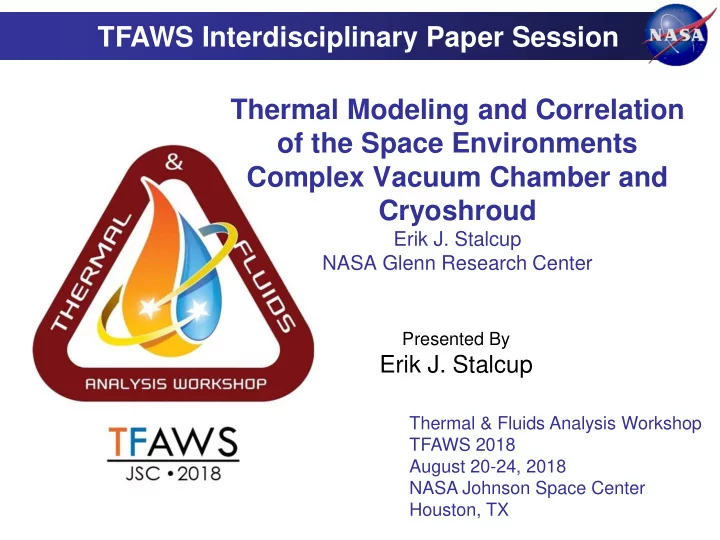

TFAWS Interdisciplinary Paper Session Thermal Modeling and Correlation of the Space Environments Complex Vacuum Chamber and Cryoshroud Erik J. Stalcup NASA Glenn Research Center Presented By Erik J. Stalcup Thermal & Fluids Analysis Workshop TFAWS 2018 August 20-24, 2018 NASA Johnson Space Center Houston, TX
Outline • Background on the SEC Vacuum Chamber and Cryoshroud • Model Description • Model Correlation – Integrated System Tests – Bake-out Test • Summary TFAWS 2018 – August 20-24, 2018 2
Space Environments Complex • Formerly known as the Space Power Facility (SPF) • Located at Plum Brook Station in Sandusky, OH • Houses large-scale test facilities including the Space Simulation Vacuum Chamber – Largest vacuum chamber in the world – 100 ft diameter, 122 ft tall – Cryoshroud operates between -250 ° F and +140 ° F – To be used for Orion EM-1 thermal vacuum test TFAWS 2018 – August 20-24, 2018 3
Thermal Model Overview • Thermal Desktop model of vacuum chamber, cryoshroud, mechanical ground support equipment (MGSE) including fluid model of GN2 • Primary uses: – Predict MGSE temperatures – Predict heat load on GN2 system • Includes 96 TD Temperature Measures that represent test thermocouples • Steady state correlation with 3 tests – 2 hot – 1 cold TFAWS 2018 – August 20-24, 2018 4
Model Description Cryofloor Transfer Cart (CTC) TFAWS 2018 – August 20-24, 2018 5
Model Description Cryofloor TFAWS 2018 – August 20-24, 2018 6
Model Description Flat Beam Interface (FBI) and Cryofloor Interface Adapter (CIA) TFAWS 2018 – August 20-24, 2018 7
Model Description Thermal vacuum configuration TFAWS 2018 – August 20-24, 2018 8
Model Description Cryowalls, cryoceiling, supply/return pipes TFAWS 2018 – August 20-24, 2018 9
Model Description Insulation TFAWS 2018 – August 20-24, 2018 10
Model Description Masts TFAWS 2018 – August 20-24, 2018 11
Model Description Vacuum chamber TFAWS 2018 – August 20-24, 2018 12
Integrated System Tests • Two ISTs performed with no MGSE inside the cryoshroud – Insulated test: operated at 170 ° F for 37 hours – Uninsulated test: operated at 170 ° F for 14 days • Only cryoshroud thermocouples were installed TFAWS 2018 – August 20-24, 2018 13
IST Correlation: SE Cryowall Uninsulated Insulated >174.88 174.88 173.01 171.16 169.30 167.43 165.58 163.71 161.85 160.00 158.13 156.27 <156.27 TFAWS 2018 – August 20-24, 2018 14 Temperature [F]
IST Correlation: Cryofloor >174.87 Uninsulated Insulated 174.87 172.33 169.77 167.23 164.68 162.14 159.58 157.05 154.49 151.95 149.40 <149.40 Temperature [F] TFAWS 2018 – August 20-24, 2018 15
IST Correlation: SE Cryoceiling >174.67 174.67 173.26 Uninsulated Insulated 171.86 170.44 169.03 167.63 166.23 164.82 163.42 162.00 160.59 <160.59 Temperature [F] TFAWS 2018 – August 20-24, 2018 16
IST Correlation • Generally good agreement between model and test data except cryoceiling intermediate header • Model predicted large regions of zero flow • Adding 5x multiplier to heat transfer coefficient resulted in much better agreement Insulated Uninsulated IST IST Average Error (°F) 0.3 0.6 RMS Error (°F) 1.1 3.7 TFAWS 2018 – August 20-24, 2018 17
Bake-out Test • Bake-out was performed to collect data on chamber cleanliness, pressure environments, and operations • Consisted of several hot and cold plateaus • Correlating from data at -263 ° F for 3 days • Only FBI and CIA inside cryoshroud • Correlation approach: 1. Reevaluate cryoshroud predictions 2. Adjust contact conductances for MGSE inside and in contact with cryoshroud (FBI, CIA, CTC) 3. Adjust insulation and contact conductances for MGSE outside cryoshroud (masts) TFAWS 2018 – August 20-24, 2018 18
Bake-out Correlation • Reevaluating cryoshroud predictions: – 81 thermocouples on cryoshroud – RMS error = 1.6 ° F • Still acceptable, no changes needed TFAWS 2018 – August 20-24, 2018 19
Bake-out Correlation • Adjusting contact conductances between: – FBI and CTC – CIA and CTC – Cryofloor and CTC (via isolators) – CTC and chamber floor (via dollies and wheels) • Utilized SINDA/FLUINT optimization algorithms – Seeking values of the 4 contact conductances that minimize the RMS error for the 12 thermocouples on these structures – Converged in 43 iterations – RMS error = 5.3 ° F TFAWS 2018 – August 20-24, 2018 20
Bake-out Correlation • Uncorrelated model predicted warmer temperature outside the shroud – Increasing insulation emissivity had little effect – As-installed photos showed considerable contact between insulation and cryoshroud • Utilized SINDA/FLUINT optimization algorithms – Adjustable parameters of contact conductance between • Insulation and cryoshroud • Masts and chamber floor – Minimizing RMS error for 3 thermocouples (2 on mast, 1 “floating”) RMS error = 5.0 ° F – TFAWS 2018 – August 20-24, 2018 21
Bake-out Correlation • Overall, model is well correlated • Potential source of error is the assumption that contact between large surfaces is uniform, e.g. insulation and cryoshroud, cryofloor and CTC Cryoshroud Interior Exterior Total (81 TCs) (12 TCs) (3 TCs) (96 TCs) Average Error (°F) -0.9 0.1 4.7 -0.3 RMS Error (°F) 1.6 5.3 5.0 2.6 TFAWS 2018 – August 20-24, 2018 22
Summary • Model is well correlated, RMS error = 2.6 ° F • Using SINDA/FLUINT optimization algorithms is an effective way to do model correlation • Future work – Transient correlation with bake-out data – Integration with vehicle model and facility FLUINT model TFAWS 2018 – August 20-24, 2018 23
Acknowledgements Thanks to the thermal team at NASA GRC and Plum Brook: Jim Yuko, Barbara Sakowski, Jarred Wilhite, Henry Speier, and Erin Reed. Thanks to Justin Elchert and Katie Oriti who developed earlier versions of this model. Questions? TFAWS 2018 – August 20-24, 2018 24
Recommend
More recommend